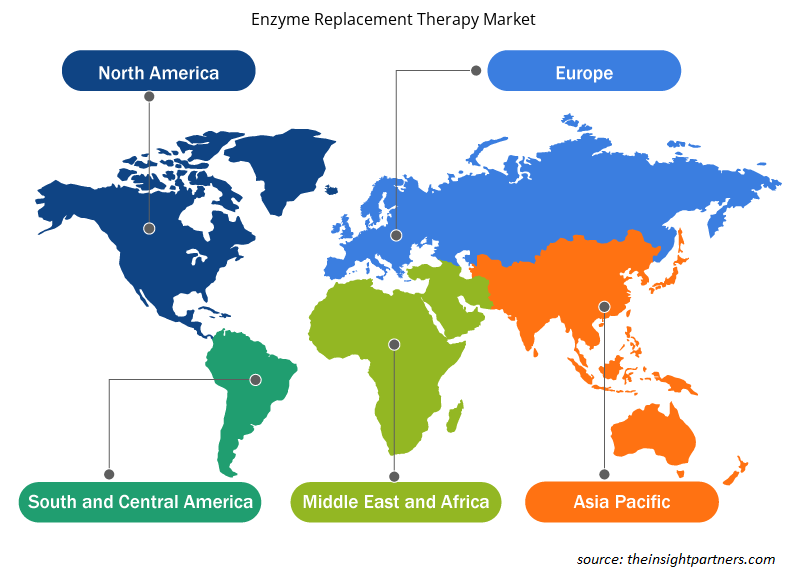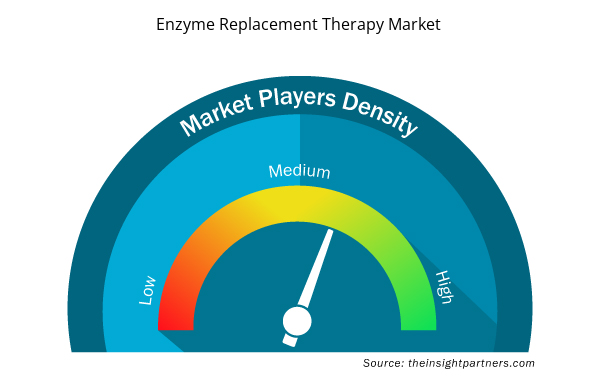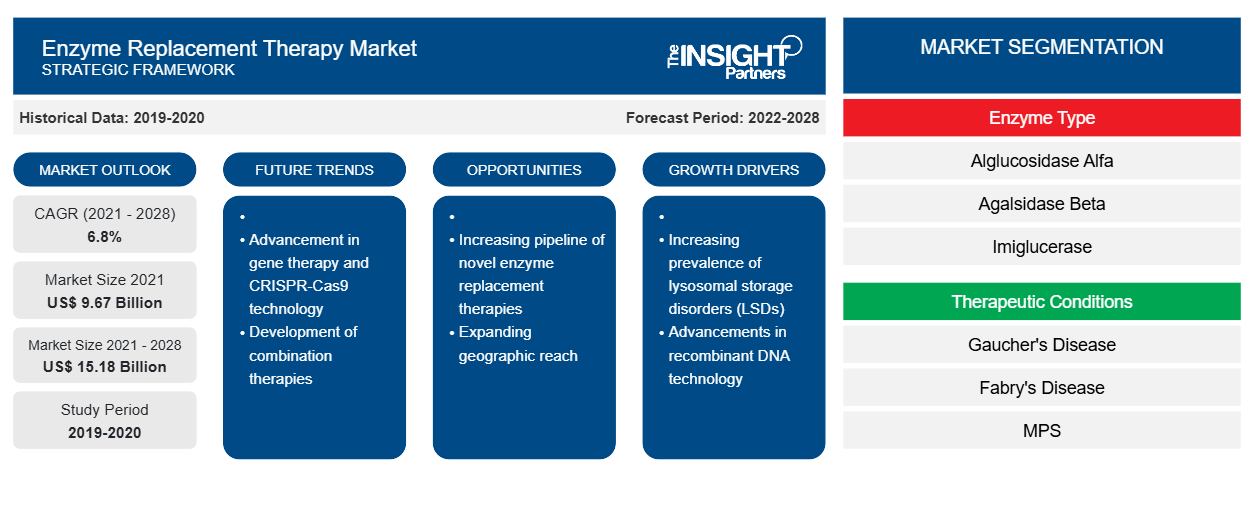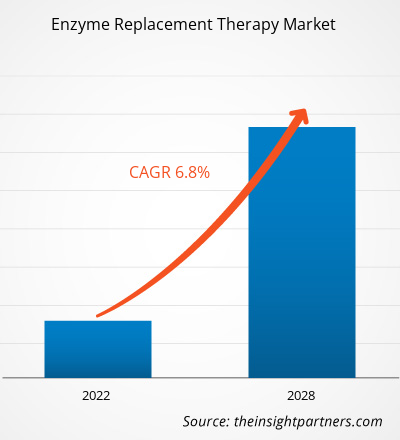Se espera que el mercado de terapia de reemplazo enzimático crezca de US$ 9.673,39 millones en 2021 a US$ 15.184,70 millones en 2028; se estima que crecerá a una CAGR del 6,8% entre 2022 y 2028.
La terapia de reemplazo enzimático ( ERT ) se realiza para tratar deficiencias enzimáticas congénitas mediante el uso de enzimas o proteínas que tienen actividad enzimática. Las enzimas animales, humanas y modificadas genéticamente son algunas de las fuentes de enzimas necesarias para el tratamiento. La terapia se aplica generalmente en enfermedades raras y de almacenamiento lisosomal, incluidas la enfermedad de Pompe , la enfermedad de Fabry , la enfermedad de Gaucher, la enfermedad de Tay-Sachs y el síndrome de Hurler. El método de ERT más común son las infusiones intravenosas, en las que la enzima de reemplazo se administra directamente en el torrente sanguíneo a través de un goteo controlado de líquidos. El crecimiento del mercado mundial de terapia de reemplazo enzimático se atribuye a la creciente prevalencia de enfermedades de almacenamiento lisosomal ( LSD ) y la rápida aprobación regulatoria con otros beneficios de comercialización para medicamentos con designación de medicamento huérfano. Sin embargo, la competencia feroz entre los actores del mercado obstaculiza el crecimiento del mercado.
El informe ofrece información y un análisis profundo del mercado mundial de terapia de reemplazo enzimático, haciendo hincapié en varios parámetros que incluyen tendencias del mercado, avances tecnológicos, dinámica del mercado y análisis del panorama competitivo de los principales actores del mercado mundial. También incluye el impacto de la pandemia de COVID-19 en el mercado en todas las regiones. Debido a la pandemia de COVID-19, muchas autoridades sanitarias se centraron en la atención relacionada con la pandemia. Además, muchos pacientes que necesitaban terapia de reemplazo enzimático se perdieron sus infusiones en marzo de 2020 debido a la insuficiencia de los servicios hospitalarios para hacer frente a la carga de los pacientes con COVID-19. Los pacientes que necesitaban ERT afirmaron sentirse ansiosos durante las admisiones hospitalarias o con respecto al suministro de medicamentos. Además, los estudios revelaron que algunos pacientes tenían depresión y una mayor cantidad de ansiedad. Por lo tanto, las sesiones programadas de terapia de reemplazo enzimático ( ERT ) se interrumpieron durante la pandemia de COVID-19, lo que provocó un impacto negativo en el mercado.
Personalice este informe según sus necesidades
Obtendrá personalización en cualquier informe, sin cargo, incluidas partes de este informe o análisis a nivel de país, paquete de datos de Excel, así como también grandes ofertas y descuentos para empresas emergentes y universidades.
- Obtenga las principales tendencias clave del mercado de este informe.Esta muestra GRATUITA incluirá análisis de datos, desde tendencias del mercado hasta estimaciones y pronósticos.
Perspectivas basadas en la geografía
Por geografía, el mercado global de terapia de reemplazo enzimático está segmentado en América del Norte (EE. UU., Canadá y México), Europa (Francia, Alemania, Reino Unido, España, Italia y el resto de Europa), Asia Pacífico (China, India, Japón, Australia, Corea del Sur y el resto de APAC ), Medio Oriente y África (Arabia Saudita, Emiratos Árabes Unidos , Sudáfrica y el resto de MEA ) y América del Sur y Central (Brasil, Argentina y el resto de América del Sur y Central).
Perspectivas del mercado
Aumento de la prevalencia de enfermedades de depósito lisosomal ( EDL )
Un lisosoma es un orgánulo celular rodeado de membrana que contiene enzimas digestivas . Un lisosoma es el centro celular clave para el catabolismo , reciclaje y señalización de macromoléculas . Cualquier defecto en estas funciones conduce a la acumulación o almacenamiento de macromoléculas en los lisosomas, lo que resulta en daño celular. La principal causa de las enfermedades de almacenamiento lisosomal ( LSD ) son las mutaciones en los genes responsables de codificar una enzima lisosomal. Además, las LSD se caracterizan por ser un error innato del metabolismo que resulta en la ausencia o deficiencia de una enzima. Los bebés y los niños sufren más severamente en comparación con los adultos, ya que los niños pueden heredar el gen defectuoso de uno o ambos padres. Sin embargo, desde la última década, el patrón ha estado cambiando y las LSD son más comunes en adultos.
Además, las enfermedades de almacenamiento lisosomal son aproximadamente 70 enfermedades, entre ellas la enfermedad de Gaucher, la enfermedad de Niemann-Pick, la enfermedad de Fabry, la enfermedad de Tay-Sachs, las enfermedades de mucopolisacaridosis (MPS) y la enfermedad de Pompe. Estos trastornos son poco frecuentes individualmente, pero en conjunto son significativamente prevalentes y afectan a 1 de cada 5.000 nacidos vivos. Muchos países realizaron encuestas para comprender el patrón de prevalencia, y la prevalencia general estaba aumentando. Por ejemplo, un estudio publicado en The Lancet Regional Health titulado "Prevalencia de trastornos de almacenamiento lisosomal en Australia de 2009 a 2020" reveló los siguientes resultados:
- La prevalencia en la población australiana es 1,6 veces mayor (1 por cada 4.800 nacidos vivos) que la prevalencia notificada en 1996 (1 por cada 7.700 nacidos vivos).
- La enfermedad de Fabry fue la más prevalente y representó el 34% de todos los diagnósticos (hasta 2020).
- Los LSD son más comunes en la edad adulta que en la infancia.
Por lo tanto, la creciente prevalencia de LSD y las terapias limitadas para curar la enfermedad están impulsando el crecimiento del mercado mundial de terapia de reemplazo enzimático.
Información basada en el tipo de enzima
Según el tipo de enzima, el mercado mundial de terapia de reemplazo enzimático se segmenta en alglucosidasa alfa, agalsidasa beta, imiglucerasa, idursulfasa, galsulfasa, velaglucerasa alfa y otras enzimas. En 2021, el segmento de otras enzimas representó la mayor participación de mercado. Se espera que el mismo segmento registre la CAGR más alta del mercado entre 2022 y 2028.
Perspectivas basadas en condiciones terapéuticas
Según las condiciones terapéuticas, el mercado mundial de terapia de reemplazo enzimático se segmenta en enfermedad de Gaucher, enfermedad de Fabry , enfermedad de Pompe , SCID, MPS y otras condiciones terapéuticas. El segmento de la enfermedad de Gaucher tuvo la mayor participación de mercado en 2021 y se espera que registre la CAGR más alta durante el período de pronóstico.
Información basada en la ruta de administración
Según la vía de administración, el mercado mundial de terapia de reemplazo enzimático se divide en parenteral y oral. El segmento parenteral tuvo una mayor participación de mercado en 2021 y se prevé que registre una CAGR más alta durante el período de pronóstico.
Perspectivas regionales del mercado de terapia de reemplazo enzimático
Los analistas de Insight Partners explicaron en detalle las tendencias y los factores regionales que influyen en el mercado de terapia de reemplazo enzimático durante el período de pronóstico. Esta sección también analiza los segmentos y la geografía del mercado de terapia de reemplazo enzimático en América del Norte, Europa, Asia Pacífico, Medio Oriente y África, y América del Sur y Central.

- Obtenga datos regionales específicos para el mercado de terapia de reemplazo enzimático
Alcance del informe de mercado sobre terapia de reemplazo enzimático
| Atributo del informe | Detalles |
|---|---|
| Tamaño del mercado en 2021 | US$ 9,67 mil millones |
| Tamaño del mercado en 2028 | US$ 15,18 mil millones |
| CAGR global (2021-2028) | 6,8% |
| Datos históricos | 2019-2020 |
| Período de pronóstico | 2022-2028 |
| Segmentos cubiertos | Por tipo de enzima
|
| Regiones y países cubiertos | América del norte
|
| Líderes del mercado y perfiles de empresas clave |
|
Densidad de actores del mercado de terapia de reemplazo enzimático: comprensión de su impacto en la dinámica empresarial
El mercado de terapias de reemplazo enzimático está creciendo rápidamente, impulsado por la creciente demanda de los usuarios finales debido a factores como la evolución de las preferencias de los consumidores, los avances tecnológicos y una mayor conciencia de los beneficios del producto. A medida que aumenta la demanda, las empresas amplían sus ofertas, innovan para satisfacer las necesidades de los consumidores y aprovechan las tendencias emergentes, lo que impulsa aún más el crecimiento del mercado.
La densidad de actores del mercado se refiere a la distribución de las empresas o firmas que operan dentro de un mercado o industria en particular. Indica cuántos competidores (actores del mercado) están presentes en un espacio de mercado determinado en relación con su tamaño o valor total de mercado.
Las principales empresas que operan en el mercado de terapia de reemplazo enzimático son:
- Sanofi
- Compañía farmacéutica BioMarin Inc.
- Compañía farmacéutica Takeda limitada
- Compañía: AbbVie Inc.
- Productos farmacéuticos Janssen (Johnson & Johnson Services, Inc.)
Descargo de responsabilidad : Las empresas enumeradas anteriormente no están clasificadas en ningún orden particular.

- Obtenga una descripción general de los principales actores clave del mercado de terapia de reemplazo enzimático
Información basada en el usuario final
Según el usuario final, el mercado mundial de terapia de reemplazo enzimático se segmenta en hospitales, centros de infusión y otros. El segmento de hospitales tuvo la mayor participación de mercado en 2021. Sin embargo, se espera que el segmento de centros de infusión registre la CAGR más alta durante el período de pronóstico.
Los actores del mercado global de terapia de reemplazo enzimático adoptan estrategias orgánicas, que incluyen el lanzamiento y la expansión de productos, para expandir su presencia y cartera de productos en todo el mundo y satisfacer la creciente demanda. Algunos de los principales actores que contribuyen al mercado son Takeda Pharmaceutical Company Limited; Sanofi SA; AbbVie Inc.; BioMarin Pharmaceutical Inc.; Amicus Therapeutics; Alexion Pharmaceuticals, Inc. (AstraZeneca); Janssen Pharmaceuticals (Johnson & Johnson Services, Inc.); Recordati SpA; Pfizer Inc.; y CHIESI Farmaceutici SpA.
- Análisis histórico (2 años), año base, pronóstico (7 años) con CAGR
- Análisis PEST y FODA
- Tamaño del mercado Valor/volumen: global, regional, nacional
- Industria y panorama competitivo
- Conjunto de datos de Excel



Report Coverage
Revenue forecast, Company Analysis, Industry landscape, Growth factors, and Trends

Segment Covered
This text is related
to segments covered.

Regional Scope
North America, Europe, Asia Pacific, Middle East & Africa, South & Central America

Country Scope
This text is related
to country scope.
Preguntas frecuentes
Global enzyme replacement therapy market is segmented by region into North America, Europe, Asia Pacific, Middle East & Africa, and South & Central America. In North America, the U.S. is the largest market for enzyme replacement therapy market. A rise in the prevalence of lysosomal storage diseases such as Gaucher’s, Pompe’s, and Fabry’s diseases, increasing regulatory approval, favorable regulatory support by the government, and the availability of various ERT products will drive enzyme replacement therapy market growth in North America. However, the growing government funding for rare disease treatment, increasing clinical trials, an increasing number of product approvals, and expanding partnerships among key players are the key factors responsible for the Asia-Pacific regional growth of the enzyme replacement therapy market accounting fastest growth in the region during the coming years.
The hospitals segment dominated the global enzyme replacement therapy market and accounted for the largest market share of 49.00% in 2021.
Takeda Pharmaceutical Company Limited, Sanofi, AbbVie Inc., BioMarin Pharmaceutical Inc., Amicus Therapeutics, Alexion Pharmaceuticals, Inc.(AstraZeneca), Janssen Pharmaceuticals (Johnson & Johnson Services, Inc.), Recordati S.p.A., Pfizer Inc., and CHIESI Farmaceutici S.p.A. are among the leading companies operating in the enzyme replacement therapy market
Based on route of administration, parenteral route of administration segment took the forefront lead in the worldwide market by accounting largest share in 2021 and is expected to continue to do so till the forecast period.
Based on therapeutic conditions, Gaucher's disease segment took the forefront lead in the worldwide market by accounting largest share in 2021 and is expected to continue to do so till the forecast period.
Based on enzyme type, other enzymes segment took the forefront lead in the worldwide market by accounting largest share in 2021 and is expected to continue to do so till the forecast period. Other enzymes include taliglucerase, laronidase, agalsidase alfa, eliglustat, cipaglucosidase alfa, miglustat, elosulfase alfa, elapegademase, velmanase alfa, pancreatic enzymes, pegademase, sebelipase alfa, cerliponase alfa, among others.
Enzyme replacement therapy (ERT) is a treatment that replaces enzymes that are not present or are deficient in the body. This is usually done by giving the patient an intravenous (IV) infusion or oral solution in which the enzyme is present. ERT is available for various lysosomal storage diseases which include Fabry’s disease, Gaucher’s disease, Pompe’s disease, MPS, and others. The ERT only increases the concentration of the enzymes which is lacking in the patient body and it does not correct any underlying genetic defect. ERT has also been used to treat patients with severe combined immunodeficiency (SCID) resulting from an adenosine deaminase deficiency (ADA-SCID).
Rising prevalence of lysosomal storage diseases (LSDS) and rapid regulatory approval with other benefits for drug with orphan drug designation are the most significant factors responsible for the overall market growth.
Trends and growth analysis reports related to Life Sciences : READ MORE..
The List of Companies - Enzyme Replacement Therapy Market
- Sanofi
- BioMarin Pharmaceutical Inc.
- Takeda Pharmaceutical Company Limited
- AbbVie Inc.
- Janssen Pharmaceuticals (Johnson & Johnson Services, Inc.)
- Alexion Pharmaceuticals, Inc (AstraZeneca)
- Amicus Therapeutics
- Recordati S.p.A.
- CHIESI Farmaceutici S.p.A.
- Pfizer Inc.
The Insight Partners performs research in 4 major stages: Data Collection & Secondary Research, Primary Research, Data Analysis and Data Triangulation & Final Review.
- Data Collection and Secondary Research:
As a market research and consulting firm operating from a decade, we have published and advised several client across the globe. First step for any study will start with an assessment of currently available data and insights from existing reports. Further, historical and current market information is collected from Investor Presentations, Annual Reports, SEC Filings, etc., and other information related to company’s performance and market positioning are gathered from Paid Databases (Factiva, Hoovers, and Reuters) and various other publications available in public domain.
Several associations trade associates, technical forums, institutes, societies and organization are accessed to gain technical as well as market related insights through their publications such as research papers, blogs and press releases related to the studies are referred to get cues about the market. Further, white papers, journals, magazines, and other news articles published in last 3 years are scrutinized and analyzed to understand the current market trends.
- Primary Research:
The primarily interview analysis comprise of data obtained from industry participants interview and answers to survey questions gathered by in-house primary team.
For primary research, interviews are conducted with industry experts/CEOs/Marketing Managers/VPs/Subject Matter Experts from both demand and supply side to get a 360-degree view of the market. The primary team conducts several interviews based on the complexity of the markets to understand the various market trends and dynamics which makes research more credible and precise.
A typical research interview fulfils the following functions:
- Provides first-hand information on the market size, market trends, growth trends, competitive landscape, and outlook
- Validates and strengthens in-house secondary research findings
- Develops the analysis team’s expertise and market understanding
Primary research involves email interactions and telephone interviews for each market, category, segment, and sub-segment across geographies. The participants who typically take part in such a process include, but are not limited to:
- Industry participants: VPs, business development managers, market intelligence managers and national sales managers
- Outside experts: Valuation experts, research analysts and key opinion leaders specializing in the electronics and semiconductor industry.
Below is the breakup of our primary respondents by company, designation, and region:

Once we receive the confirmation from primary research sources or primary respondents, we finalize the base year market estimation and forecast the data as per the macroeconomic and microeconomic factors assessed during data collection.
- Data Analysis:
Once data is validated through both secondary as well as primary respondents, we finalize the market estimations by hypothesis formulation and factor analysis at regional and country level.
- Macro-Economic Factor Analysis:
We analyse macroeconomic indicators such the gross domestic product (GDP), increase in the demand for goods and services across industries, technological advancement, regional economic growth, governmental policies, the influence of COVID-19, PEST analysis, and other aspects. This analysis aids in setting benchmarks for various nations/regions and approximating market splits. Additionally, the general trend of the aforementioned components aid in determining the market's development possibilities.
- Country Level Data:
Various factors that are especially aligned to the country are taken into account to determine the market size for a certain area and country, including the presence of vendors, such as headquarters and offices, the country's GDP, demand patterns, and industry growth. To comprehend the market dynamics for the nation, a number of growth variables, inhibitors, application areas, and current market trends are researched. The aforementioned elements aid in determining the country's overall market's growth potential.
- Company Profile:
The “Table of Contents” is formulated by listing and analyzing more than 25 - 30 companies operating in the market ecosystem across geographies. However, we profile only 10 companies as a standard practice in our syndicate reports. These 10 companies comprise leading, emerging, and regional players. Nonetheless, our analysis is not restricted to the 10 listed companies, we also analyze other companies present in the market to develop a holistic view and understand the prevailing trends. The “Company Profiles” section in the report covers key facts, business description, products & services, financial information, SWOT analysis, and key developments. The financial information presented is extracted from the annual reports and official documents of the publicly listed companies. Upon collecting the information for the sections of respective companies, we verify them via various primary sources and then compile the data in respective company profiles. The company level information helps us in deriving the base number as well as in forecasting the market size.
- Developing Base Number:
Aggregation of sales statistics (2020-2022) and macro-economic factor, and other secondary and primary research insights are utilized to arrive at base number and related market shares for 2022. The data gaps are identified in this step and relevant market data is analyzed, collected from paid primary interviews or databases. On finalizing the base year market size, forecasts are developed on the basis of macro-economic, industry and market growth factors and company level analysis.
- Data Triangulation and Final Review:
The market findings and base year market size calculations are validated from supply as well as demand side. Demand side validations are based on macro-economic factor analysis and benchmarks for respective regions and countries. In case of supply side validations, revenues of major companies are estimated (in case not available) based on industry benchmark, approximate number of employees, product portfolio, and primary interviews revenues are gathered. Further revenue from target product/service segment is assessed to avoid overshooting of market statistics. In case of heavy deviations between supply and demand side values, all thes steps are repeated to achieve synchronization.
We follow an iterative model, wherein we share our research findings with Subject Matter Experts (SME’s) and Key Opinion Leaders (KOLs) until consensus view of the market is not formulated – this model negates any drastic deviation in the opinions of experts. Only validated and universally acceptable research findings are quoted in our reports.
We have important check points that we use to validate our research findings – which we call – data triangulation, where we validate the information, we generate from secondary sources with primary interviews and then we re-validate with our internal data bases and Subject matter experts. This comprehensive model enables us to deliver high quality, reliable data in shortest possible time.


 Obtenga una muestra gratuita de este informe
Obtenga una muestra gratuita de este informe